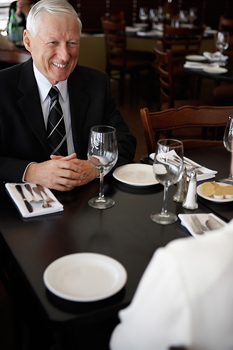
“Wanna grab lunch?” Do you dread or covet this invitation during your busy workweek? Are you a stoic solo luncher? Do you plow through the midday meal?
Now, put down your microwaved chicken and broccoli casserole and consider this: You’re not alone. A recent Accountemps survey found that while employees prefer to break from work with a colleague, they more commonly have lunch alone. Or fail to take a break at all. Really.
But it doesn’t have to be this way. You can become a lunch-break aficionado. It’s possible to unwind a bit, tease out workplace matters with a colleague, go the gym, nap for 20 minutes, clear your head, digest your meal — all with the goal of coming back to work recharged, better connected and with a boost in your productivity.
To delve into the matter, I spoke with Bill Driscoll, district president of Accountemps, an expert on global staffing, recruiting, hiring, and other workplace issues. Following are his five tips for better lunch breaks:
1. Be with colleagues
Nearly half of accounting and finance professionals surveyed said they typically spend their lunch break eating alone. Yet almost as many said they would rather have a coworker join them for the meal.
Ask a coworker to join you on your break and reap the rewards of companionship and communication. After all, you’re probably both thinking the same thing.
2. Pause and refresh
About 37 percent of those interviewed said they would like to exercise on their lunch breaks, but only 10 percent actually do. Survey respondents more frequently run errands, check personal email and surf the Internet during their break.
Buck the trend. Use that company gym perk, or take a 15-minute power walk across campus. Under no circumstances should you stay tethered to your workstation during your break.
“Even with demanding workloads, you should periodically step away from your desk during the workday,” Driscoll advised.
3. Exchange ideas
Lunching with colleagues can provide an opportunity to brainstorm and inspire new ideas. You can discuss the latest office technology or ways tasks are completed in other departments.
Driscoll said, “Sharing a meal with coworkers not only strengthens business relationships, but creates a more relaxed environment for collaboration and the exchange of ideas.”
4. Clear your head and boost creativity
“The simple act of taking a break — even for a few minutes — can help clear your mind and broaden your perspective, especially when facing challenging business problems,” Driscoll noted.
Discuss things on your break other than work to boost your energy and elevate your mood. The brief interruption will help you regain focus and may even lead to new solutions to problems or tasks.
5. Make a plan
Don’t rush from lunch into a power meeting. When possible, schedule your more demanding conversations 30 minutes or more after you’ve taken your break.
As reported in a Scientific American article, a rested mind is a more productive mind. In addition, a study published in the journal Cognition highlights another upside to sporadic breaks that we rarely consider: goal reactivation.
So take that break and enjoy your respite. It’s benefiting not only you but also your company and colleagues.



